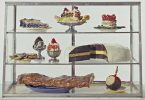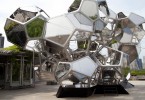Picasso Black and White
Written by Christine Ritenis
New York Art Correspondent for Connoisseur Magazine

Her shoulder is sharp and angular, her torso slender, and strands of moist-looking hair drape her face, as if effort had caused them to slip out of a hair clip or tie. Her upper body leans forward, its full weight on the iron, and her lips are a straight line. “Woman Ironing,” an oil painting by Pablo Picasso that is currently on display in Picasso Black and White at the Solomon R. Guggenheim Museum in New York, gives the impression that the ironer has labored for a lifetime and that the backbreaking task will occupy her until death. Created during Picasso’s Blue Period, the painting evokes many of the themes that most concerned him then—loneliness, poverty, and despair—and demonstrates his fascination with solitary figures. There are touches of yellow, perhaps a spot of red, but the tones are overwhelmingly gray, reflecting the woman’s grim reality. Despite the wretchedness portrayed, the oil is beautiful, heart-stopping even.






